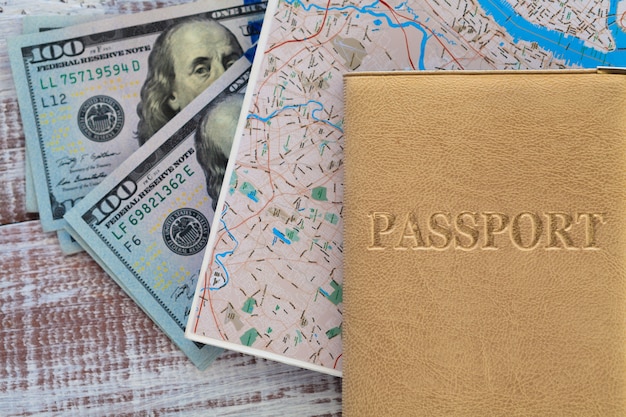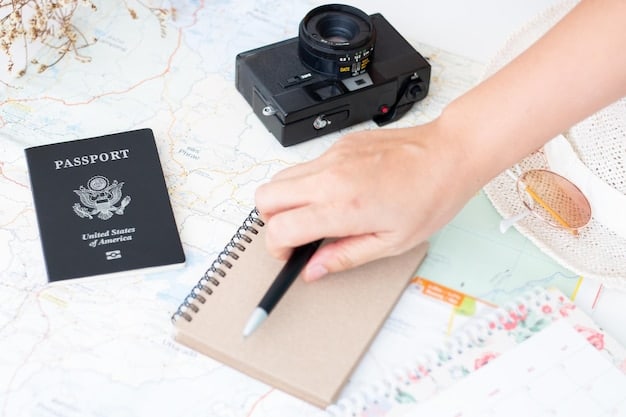US Passport Ready? Avoid 2025 International Travel Delays

Proactive passport renewal is crucial for US travelers eyeing international trips in 2025, as upcoming changes and processing backlogs could significantly delay travel plans, emphasizing the urgency of early preparation.
Planning international travel for 2025 can be an exciting prospect, filled with dreams of exotic destinations and new experiences. However, the unexpected can quickly turn excitement into frustration if you overlook a critical detail: your passport’s validity. Ensuring Is Your US Passport Ready? Avoid International Travel Delays in 2025 with These Renewal Tips is not just a recommendation; it’s a necessity as enhanced security measures and potential processing backlogs loom large for the coming year.
The Looming 2025 Travel Landscape: What You Need to Know
As we approach 2025, the landscape for international travel is evolving, bringing with it new regulations and potential challenges for US passport holders. Many countries, particularly those in the Schengen Area of Europe, are implementing stricter entry requirements. This includes the ETIAS (European Travel Information and Authorization System), which, while not a visa, will require US citizens to obtain pre-travel authorization, adding another layer to travel preparation. The implementation of such systems underscores a global trend towards enhanced border security, making a valid, up-to-date passport more critical than ever.
Beyond new regulations, the post-pandemic travel surge continues to strain passport processing services worldwide. While significant progress has been made in clearing backlogs, sporadic surges in applications can still lead to unexpected delays. The US State Department periodically updates its processing times, but these are estimates and can fluctuate based on demand. Waiting until the last minute is a gamble that international travelers can ill afford, especially with non-refundable bookings on the line. Understanding these forthcoming changes and potential bottlenecks is the first step in safeguarding your 2025 travel plans.
Understanding ETIAS and Other Emerging Requirements
The European Travel Information and Authorization System (ETIAS) is set to become operational in 2025, affecting US citizens traveling to many European countries. It’s an electronic system that allows pre-screening of travelers before they enter the Schengen Area, enhancing security. While applying for ETIAS is generally straightforward and done online, it’s an additional step that can’t be completed without a valid passport.
- 🇪🇺 ETIAS Requirement: US citizens visiting Schengen Area countries will need ETIAS authorization starting in 2025.
- 🗓️ Passport Validity: Your passport must be valid for at least three months beyond your intended departure date from the Schengen Area.
- ⏳ Application Time: ETIAS applications are usually processed quickly, but delays can occur, making a valid passport essential.
Global Passport Validity Rules: The 6-Month Rule
Many countries enforce what’s known as the “6-month rule,” requiring your passport to be valid for at least six months beyond your planned date of entry or departure. Failure to comply can result in denied boarding or entry. This rule is a common cause of unexpected travel disruptions and emphasizes the need for early passport checks. For those even considering international travel in late 2025, checking your passport’s expiration date now is vital to ensure it meets this widespread international standard.
The six-month validity rule is not universal, but it is widespread enough that treating it as a default for any international trip is a prudent approach. Airlines often enforce this rule stringently, as they can face penalties for transporting passengers who do not meet destination country entry requirements. Therefore, even if your chosen destination technically requires less validity, ensuring you have at least six months remaining on your passport provides a significant buffer against unforeseen issues.
Checking Your Current Passport Status: The First Critical Step
Before you even think about booking flights or accommodations for your 2025 international adventures, the very first task on your preparation checklist must be to check the status of your US passport. This initial assessment is paramount to avoiding future stress and potential travel disruptions. Many travelers discover too late that their passport is expired or will expire within the six-month window required by numerous countries, leading to last-minute panic and expedited processing fees.

Start by physically locating your passport and examining its expiration date. Do not rely on memory or old travel plans. A quick glance at the exact date can save you significant headaches down the line. Remember, the date printed on your passport is the absolute final day it is considered valid by the US government, but most international destinations will require validity far beyond that date.
Locating Your Passport and Identifying Key Dates
Upon finding your passport, focus on two critical pieces of information: the issue date and the expiration date. A standard adult US passport is valid for ten years from its issue date. For minors (under 16), passports are valid for five years. Understanding these timelines helps you project when a renewal might be necessary, even if 2025 seems far off. If your passport expires in early 2026, for example, but you plan to travel in mid-2025, you might already be cutting it close due to the six-month rule.
It’s also wise to check for any signs of wear and tear. A damaged passport, even if technically valid, can be rejected by border officials. This includes water damage, significant tears, or a blurred photo. A passport must be in good condition to be accepted for international travel. If you notice any significant damage, you should plan for a renewal regardless of the expiration date.
Understanding Passport Validity for Minors and First-Time Applicants
The process for minors and first-time applicants has stricter requirements. Minors under 16 must apply in person with both parents or legal guardians, or one parent with documented consent from the other. Their passports are valid for five years. First-time adult applicants also need to apply in person and provide proof of US citizenship and identity. These processes generally take longer due to the in-person appointment and document verification, so factoring in extra time for these scenarios is essential for 2025 travel.
- 👶 Minor Passports: Valid for 5 years; typically require both parents to be present for application.
- 📝 First-Time Adults: Apply in person with proof of citizenship and identity.
- ⏰ Increased Processing: These applications often require more time due to additional security measures and verification steps.
For those who’ve never held a US passport or are applying for a child’s first passport, the documentation requirements are more extensive. You’ll need original birth certificates, proof of identity for applicants and parents (if applicable), and clear consent forms where necessary. These extra steps mean the application process takes significantly longer than a simple renewal. Therefore, if a first-time passport is needed for your 2025 travel, start the process as early as possible to avoid any last-minute rushes or delays that could jeopardize your plans.
Passport Renewal Process: Options and Estimated Timelines
Successfully navigating the passport renewal process requires understanding the available options and realistic timelines. The US Department of State offers several methods, each with different processing speeds and associated costs. Choosing the right method depends heavily on your travel urgency and budget. For those planning 2025 international travel, a proactive approach starting in late 2024 or early 2025 will provide the most flexibility and peace of mind.
The standard mail-in renewal is the most common and cost-effective, but it also has the longest processing times. If your travel is months away, this is usually the best option. However, as your departure date approaches, you may need to consider expedited services, which come with additional fees. It’s crucial to consult the official State Department website for the most current processing times, as these can change due to demand fluctuations.
Standard Mail-In Renewal: The Most Common Path
For eligible applicants, renewing by mail is the simplest and most economical option. You can renew by mail if your most recent passport is undamaged, was issued when you were 16 or older, was issued within the last 15 years, and was issued in your current name (or you can provide documentation of a name change). The process involves completing Form DS-82, gathering your old passport, a new photo, and the required fees, then mailing them to the National Passport Processing Center.
While convenient, standard mail renewal can take several weeks, sometimes even months, depending on the volume of applications. For 2025 travel, if your passport expires in the latter half of the year, applying now provides ample buffer time. Do not underestimate the time required for mail delivery and processing before your application even reaches an examiner. Plan for possible unforeseen delays in postal services or internal processing.
Expedited Processing: When Time is of the Essence
If your travel is imminent – typically within 6-11 weeks – expedited processing is available for an additional fee. This service significantly reduces the waiting time compared to standard processing. You can request expedited service for mail-in applications or when applying in person at a passport agency. The goal is to get your passport faster, but it is not instantaneous and still requires careful planning.
- 🚀 Faster Turnaround: Expedited services reduce processing times but incur extra costs.
- ✈️ Travel Urgency: Ideal for travel within the next 6-11 weeks.
- 📞 Appointment Required: For travel within 2-3 weeks, an in-person appointment at a passport agency is necessary.
For those needing a passport even quicker – usually within 2-3 weeks for international travel – an appointment at a regional passport agency becomes necessary. These appointments are highly sought after and require proof of urgent travel, such as flight itineraries. Securing an appointment can be competitive, especially during peak travel seasons, highlighting why early planning is always the preferred strategy.
Essential Documents and Requirements for Renewal
The success of your passport renewal application hinges on providing all the necessary documents accurately and completely. Missing information or incorrect photographs are common reasons for application delays or rejections, adding unnecessary time to the process. Being meticulous in gathering and preparing your submission can significantly streamline your renewal.
Beyond the primary form and your old passport, a compliant passport photo is often a sticking point for many applicants. It’s not just about looking good; it’s about meeting very specific size, background, and facial expression requirements. Taking the time to get this right at a professional location can save a lot of grief. Remember, attention to detail here directly translates to a smoother, faster renewal experience.
Form DS-82: The Core of Your Renewal Application
Form DS-82, “Application for a U.S. Passport by Mail,” is the cornerstone of your renewal. It must be filled out completely and accurately. You can complete the form online and print it, or print a blank form and fill it out by hand with black ink. Ensure all sections are legible and truthful. Any discrepancies can lead to delays as the State Department verifies information.
Double-check personal details like your name, date of birth, and social security number. Any recent changes, such as a name change due to marriage or divorce, require additional supporting documentation, like an original marriage certificate or court order. Failing to include these can halt your application process, even if everything else is in order.
Passport Photo Requirements: Don’t Get Rejected
Your passport photo is subject to strict guidelines. It must be a recent color photo, 2×2 inches in size, taken within the last six months, against a plain white or off-white background. You must face the camera directly with a neutral facial expression or a natural, slight smile, with both eyes open. No glasses are allowed. These rules are non-negotiable, and failing to meet them is a leading cause of application rejection.

Many drugstores and post offices offer passport photo services, which can be a worthwhile investment to ensure compliance. While it might seem tempting to take one yourself, the precise requirements for lighting, head size, and background often make professional services a wiser choice to avoid delays. Remember, a rejected photo means your application process effectively restarts from that point, adding weeks to the wait.
Proof of Identity and Citizenship: What is Needed
While renewing by mail with Form DS-82, your previous passport serves as proof of both identity and citizenship. However, if you’re applying in person, or if your previous passport has been lost or extensively damaged, you will need to provide additional documents. These typically include an original birth certificate or naturalization certificate as proof of citizenship, and a valid driver’s license or state-issued ID as proof of identity.
Always bring original documents; photocopies are usually not accepted unless specifically requested. These documents will be returned to you after your new passport is processed. The requirement for originals underscores the importance of not mailing these irreplaceable documents unless explicitly instructed to do so by the official passport renewal guidelines for your specific application type.
Tips for a Smooth and Timely Passport Renewal
A smooth and timely passport renewal can significantly reduce pre-travel anxiety. While unforeseen circumstances can always arise, proactive measures and careful attention to detail can prevent many common pitfalls. Your goal should be to submit a complete, accurate, and compliant application the first time around, minimizing any back-and-forth with the passport agency.
One of the simplest yet most effective tips is to routinely check the official US Department of State website. This is the authoritative source for processing times, fees, and requirements, all of which can change. Relying on outdated information from third-party sites can lead you down the wrong path, costing you time and money. Make it a habit to cross-reference any information with the official government site.
Apply Early: The Golden Rule of Passport Renewal
The single most important piece of advice for passport renewal is to apply early. For 2025 travel, ideally, you should aim to renew your passport in late 2024 or early 2025, even if it doesn’t expire until much later. This provides a generous buffer against unexpected delays, peak travel seasons, and processing backlogs. A good rule of thumb is to begin the renewal process as soon as your passport has less than 12-15 months of validity remaining, especially if you travel frequently.
This “golden rule” also accounts for the six-month validity rule imposed by many countries. Renewing early means you’ll easily meet this requirement, often without needing to think about it. It also gives you peace of mind, knowing that your passport is ready whenever a spontaneous travel opportunity might arise, without the stress of an impending expiration date.
Track Your Application: Stay Informed
After mailing your application, use the online status tracker provided by the Department of State. This tool allows you to monitor the progress of your application from submission to delivery. Keep your application locator number handy for quick lookups. Regular checks can alert you to any issues or requests for additional information, allowing you to respond promptly and avoid further delays.
While the tracker is helpful, understand that updates may not be instantaneous. Processing takes time, and sometimes there can be a lag between an action being taken and it appearing online. Avoid calling customer service too frequently unless your application goes significantly past the estimated processing times or if the tracker indicates an urgent issue. Patience, combined with periodic checks, is key here.
Consider Using a Reputable Expediting Service (with caution)
For extremely urgent travel needs (e.g., within a few days), and if you cannot secure an appointment at a passport agency, a reputable third-party expediting service might be an option. These services act as couriers, hand-delivering your application to a passport agency on your behalf. While they charge a significant fee, they can be invaluable in crisis situations. However, always exercise caution.
- 🚨 Extreme Urgency: Only for travel within days when other options are exhausted.
- 💰 High Cost: Expect substantial fees in addition to government processing fees.
- 🧐 Verify Legitimacy: Research thoroughly and choose only reputable, registered services.
Ensure any service you consider is registered with the Department of State and has a solid track record. Be wary of any service making unrealistic promises or demanding excessive fees. While these services can be lifesavers, they are generally a last resort due to cost and the inherent risk of trusting personal documents to a third party. Always thoroughly vet any expediting service before committing.
Planning for Unexpected Delays and Contingencies
Even with meticulous planning, international travel can present unexpected challenges, and passport issues are no exception. Preparing for contingencies is an essential part of responsible travel planning, particularly when considering the potential for high demand and unforeseen processing delays in 2025. Having a backup plan can save your trip from being derailed by a bureaucratic hiccup.
One of the most effective ways to mitigate risk is to build flexibility into your travel dates. If your itinerary allows for some wiggle room, even a few days, it can absorb minor delays in passport delivery or processing. Avoid booking non-refundable flights or accommodations too soon after your estimated passport delivery date, especially if you chose a standard processing service. A little breathing room can significantly reduce stress.
Coping with Unexpected Processing Times and Backlogs
Despite official estimates, actual passport processing times can vary due to factors like unforeseen surges in applications, staffing issues, or even natural disasters. If your renewal is taking longer than expected, resist the urge to panic. Continuously check the online status tracker and keep a close eye on the official State Department announcements regarding processing times.
If your travel date is approaching rapidly and your passport still hasn’t arrived, contact the National Passport Information Center. While they may not be able to expedite every case, they can provide guidance on what steps you can take, potentially including an urgent appointment at a passport agency if your travel is within 14 days and you meet specific criteria. Documentation of your urgent travel will be required.
Lost or Stolen Passports: Immediate Action Required
Discovering your passport is lost or stolen, whether at home or abroad, is a stressful situation. The immediate action required is to report it to the US Department of State. This can be done online, by mail using Form DS-64, “Statement Regarding a Lost or Stolen Passport,” or by phone. Reporting it prevents fraudulent use of your document and initiates the process for a replacement.
If you’re abroad and your passport is lost or stolen, contact the nearest US Embassy or Consulate immediately. They can assist you in obtaining an emergency passport (limited validity) that will allow you to return home. Be prepared to provide proof of US citizenship and identity, such as a birth certificate and driver’s license, along with a police report if possible, detailing the loss or theft. This is another reason to keep copies of important documents separate from your passport.
Beyond the Passport: Other Travel Documentation Essentials
While your US passport is undoubtedly the most critical document for international travel, it’s not the only one. Depending on your destination and the nature of your trip, you may need additional documentation, such as visas, international driving permits, or specific health certifications. Overlooking these can be just as detrimental to your travel plans as an expired passport.
Researching the entry requirements for every country you plan to visit is crucial. Don’t assume that because one country has relaxed rules, another will too. Policies can vary widely, even among neighboring nations. The official embassy or consulate website for each destination country is the most reliable source for up-to-date entry requirements.
Visas and Entry Requirements for Specific Countries
Many countries require US citizens to obtain a visa before arrival. Visa requirements can range from simple online applications (like the ETIAS for Europe, which is technically an authorization, not a visa, but serves a similar function) to complex, in-person applications at an embassy, potentially requiring interviews and extensive documentation. Always check the visa requirements for all your destination countries well in advance, as processing times for visas can be even longer than for passports.
Some countries also have specific entry rules related to your passport’s validity beyond the standard six-month rule. For example, certain nations might require 1-3 months of validity *past* your planned departure date. Always confirm these details on the official government travel advisories or embassy websites.
International Driving Permits and Health Certifications
If you plan to drive internationally, an International Driving Permit (IDP) might be required or highly recommended, even if your US driver’s license is valid. An IDP is a translation of your US driver’s license into multiple languages and is recognized in over 150 countries. It’s usually easy to obtain through organizations like AAA or AATA. However, it’s only valid when presented with your actual US driver’s license.
- 🚗 International Driving Permit (IDP): Often required for driving in foreign countries; facilitates translation of your US license.
- 💉 Health Requirements: Some destinations require proof of specific vaccinations (e.g., Yellow Fever) for entry.
- ⚕️ Travel Insurance: Always recommended for international travel to cover medical emergencies, trip cancellations, and other unforeseen events.
Furthermore, global health situations can sometimes necessitate specific health certifications, such as proof of certain vaccinations (e.g., Yellow Fever for travel to specific African or South American countries). While COVID-19 related travel restrictions have largely eased, it’s always wise to check the latest health advisories for your destination, as recommendations can change.
Conclusion: Proactive Planning for Stress-Free Travel in 2025
Navigating the complexities of international travel in 2025 requires more than just a desire to explore; it demands meticulous preparation, especially concerning your US passport. From understanding updated global entry requirements and the crucial “6-month rule” to mastering the renewal process, a proactive approach is your best defense against potential delays and disappointments. Beginning these checks and renewals early, far ahead of your planned departure, is not merely a suggestion but a critical strategy. By ensuring your passport is valid, compliant, and ready, you safeguard your adventures and move closer to experiencing the world without unnecessary stress.
| Key Point | Brief Description |
|---|---|
| ✅ Check Validity | Verify your passport’s expiration date and comply with the 6-month rule for most international destinations. |
| ⏱️ Apply Early | Submit renewal applications well in advance (12-15 months before expiration is ideal) to avoid peak season delays. |
| 📸 Photo Compliance | Ensure your passport photo meets strict 2×2 inch, white background, and neutral expression requirements. |
| 📋 Other Docs | Research visa, ETIAS, IDP, and health certificate requirements for your specific destinations. |
Frequently Asked Questions About US Passport Renewal
You should aim to renew your US passport at least 9-12 months before its expiration date, especially if you plan international travel in 2025. Many countries require passports to be valid for at least six months beyond your travel dates, so renewing early provides a crucial buffer against this rule and potential processing backlogs.
The “6-month rule” states that many countries require your passport to be valid for at least six months beyond your intended date of entry or departure. Failure to meet this requirement can result in denied boarding or entry. For 2025 travel, ensure your passport’s expiration date is at least six months after your planned return.
For a standard mail-in renewal, you will need your most recent, undamaged US passport, a completed and signed Form DS-82, a new 2×2 inch color passport photo (meeting specific requirements), and the applicable renewal fees. Ensure your name matches your previous passport or provide documentation for any name changes.
Yes, expedited processing is available for an additional fee, significantly reducing turnaround times. For very urgent travel (within 2-3 weeks), you may need to schedule an in-person appointment at a regional passport agency, often requiring proof of immediate international travel like a flight itinerary. Plan for potentially higher costs.
Depending on your destination, you might need a visa or an electronic travel authorization (like ETIAS for Europe, starting in 2025). An International Driving Permit (IDP) is often recommended if you plan to drive. Additionally, some countries require specific health certifications, such as proof of vaccinations, so always check your destination’s specific entry requirements.
Final Thoughts: Your Passport to Global Adventures
As you chart your course for 2025 international travel, remember that your US passport is your most vital credential. The difference between a seamless journey and a frustrating ordeal often lies in the forethought you invest in its validity and renewal. By proactively checking your document, understanding the evolving travel requirements, and meticulously following renewal guidelines, you are not just ticking off an item on a checklist; you are unlocking a world of opportunities and ensuring that your international adventures remain exciting, memorable, and delay-free. Make 2025 a year of discovery, not disappointment, with a passport that’s truly ready for anything.





